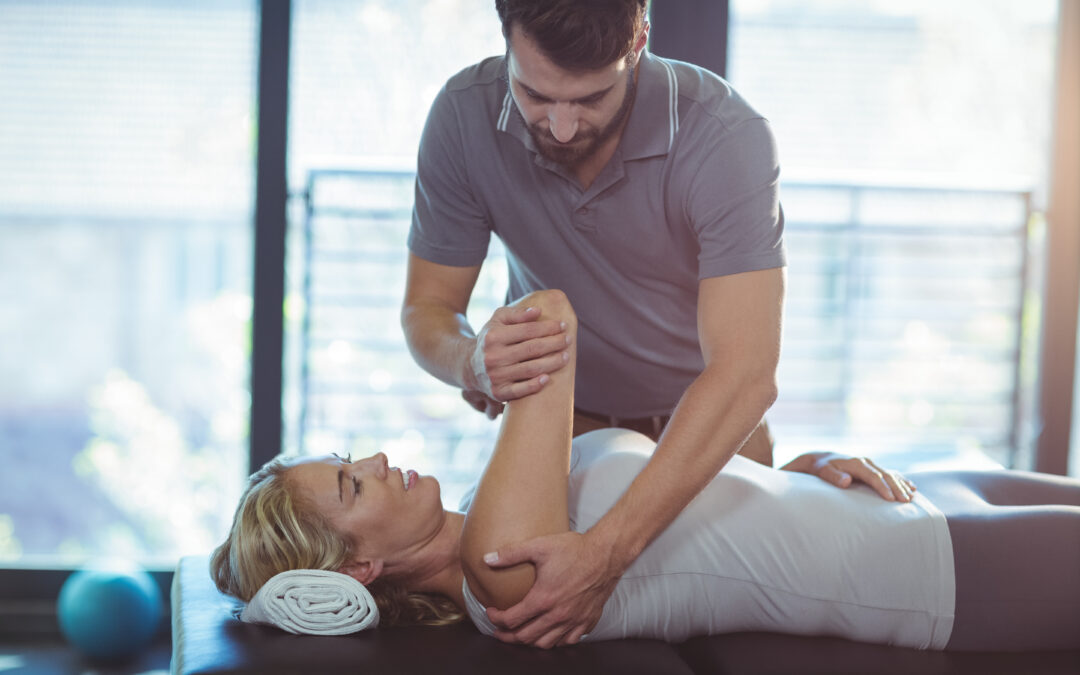Contents
Bone spurs, also known as osteophytes, are excess bone growths that occur around the joints. If you have had an injury or condition that caused a higher level of wear and tear on a specific joint, your body may begin to form extra bone to protect the damaged area. This can turn into painful bone spurs in the joints. They’re more common in older adults, and nearly 40% of the population will develop symptoms of bone spurs as they age.
Bone spurs can develop as a result of a number of different conditions, injuries, and general wear and tear. They can occur in any major joint, such as:
- Knees
- Spine
- Hips
- Shoulders
In the beginning, bone spurs may not present any symptoms or cause pain. However, as the bone spur grows and progresses, it can begin to rub up against or pinch nearby soft tissue, tendons, nerves or ligaments. For bone spurs in the shoulders, you may begin to feel shoulder pain or discomfort while using the shoulder joint. Let’s take a look at some common causes of bone spurs in the shoulder as well as what treatments may help.
Causes of bone spurs
Bone spurs in the shoulder generally occur due to inflammation in the shoulder area. They can be caused by a variety of degenerative or inflammatory conditions, as well as injuries and other risk factors. Here is a list of some of the most common causes of bone spurs in the shoulder:
- Osteoarthritis — Cartilage is an important cushion for the ends of your bones. It ensures smooth and painless movements, and it can also be a shock absorber to prevent your bones from grinding against each other. As you age, osteoarthritis can make that cartilage break down and begin to degenerate, which may cause bone spurs in some joints.
- Rheumatoid arthritis — Rheumatoid arthritis is an inflammation-based disorder that causes the immune system to attack the body, and areas such as joints and soft tissue can be affected. Pain, swelling and stiffness can occur in the shoulder and usually affect more than one joint in the body. Inflammation from rheumatoid arthritis can prompt bone spurs to begin to form.
- Tendinitis — Tendons are thick cords that link bones to nearby muscles. If the tendon along your shoulder gets inflamed, it can cause biceps tendinitis. This may result in pain in the shoulder and is often due to overexertion during physical activity over an extended period of time. Biceps tendinitis can cause tender, burning pain in and around the shoulder area and may trigger bone spurs to form.
- Injuries — If you sustain a shoulder injury, your body will automatically begin to try to protect that injured joint while you heal. While certain things, such as inflammation and swelling, can temporarily protect the joint from further damage, other reactions, such as bone spurs, can form. These may end up causing long-term pain even after the original injury has healed.
- Lack of regular exercise — Regular exercise is necessary for bone health, and a lack of it can increase the likelihood of developing bone spurs. Some exercises, such as jogging or weight training, can help strengthen bones and decrease the chances of getting painful bone spurs.
- Genetics — If you have a family history of osteoarthritis or other degenerative diseases, you may be more likely to develop a disease that could cause bone spurs. If your family has a history of bone spurs or similar conditions, talk to your health care provider to see what steps you can take to decrease your chances of developing bone spurs.
None of these conditions guarantee that you will get bone spurs or that they will occur in your shoulder joints. However, these risk factors can all increase your chances of developing them during your life.
Some bone spurs, especially if they’re small, may not even be noticeable at first. But as bone spurs develop in size, they can begin to cause pain and discomfort. If you’re wondering whether to see your doctor about bone spurs in your shoulder, here are a few symptoms that you should look out for:
- Decreased range of motion in the shoulder
- Muscle spasms
- Neck pain
- Pain in the upper back or arms
- Sharp pains that radiate across the back or through the affected arm
- Shoulder pain
- Stiffness
- Tenderness
- Tingling or numbness
- Visible inflammation
- Visible lump under the skin (large bone spurs only)
- Weakness
If you are experiencing any of the above issues in one or both of your shoulders, it’s time to talk to your doctor. This is especially important if any of your symptoms are preventing you from participating in daily activities such as driving, participating in sports, or picking up or reaching for objects. Your doctor can assess your condition and help you decide what treatment path would be most helpful for your pain.
Treatments for bone spurs
If you have mild bone spurs in your shoulder, there are some at-home treatments that may help with your symptoms. Here are a few simple ways that you can treat some symptoms of bone spurs:
- Over-the-counter pain relievers
- Ice packs
- Heat therapy
- Resting the affected shoulder
- Massage therapy for pain management
These things can be helpful if your bone spurs are small or only mildly painful. However, if your bone spurs are causing significant pain or are interfering with daily activities, don’t just treat your symptoms at home. Talk to your doctor so they can help you figure out how to treat them properly.
For bone spurs that are interfering with your day-to-day life, your doctor may recommend physical therapy or even surgery in severe cases. Manual therapy specifically is a gentle, noninvasive physical therapy treatment that can help with bone spurs.
At Lattimore PT, we have 30 physical therapists with a Certification in Orthopedic Manual Physical Therapy (COMT). This is a more intensive physical therapy training program that helps physical therapists hone their manual therapy skills to be more effective. Here are a few manual therapy modalities that may be helpful for bone spurs in the shoulder:
- Joint manipulation — This type of manual therapy can target your shoulder joint specifically to help with your overall mobility and reduce pain. It can be very effective for pain in the shoulder and elbow specifically.
- Joint mobilization — This treatment is similar to joint manipulation in that it can help with your range of motion and overall mobility. However, with joint mobilization, the movements are slower and more focused on working within the normal range of movement.
- Soft tissue manipulation — Soft tissue manipulation is often used to increase blood flow and stimulate healing around a painful joint. This can help relax the tissue around the affected joint, making other physical therapy exercises easier to perform.
- Therapeutic stretching — Assisted stretching can help you stretch and relax tight muscles more than if you were trying to stretch on your own. It can also help with overall range of motion and relieve pain and stiffness due to tight muscles and joints.
These are just some of the methods that can be used during physical therapy to help you treat your pain. Your physical therapist will evaluate your condition and devise a treatment plan specifically suited to your needs and goals.
At Lattimore PT, our goal is to help you get back to the activity level you want to achieve. Our licensed physical therapists are highly trained in a variety of techniques and physical therapy methods to find the right treatment path for you. Contact our team today for more information or to schedule an initial appointment.



